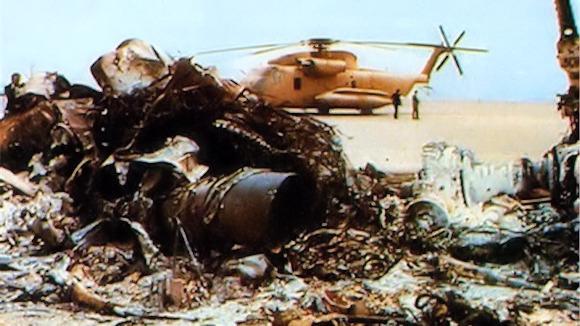Forty years ago, on April 24, 1980, the attempt by the US Army Special Forces to free a group of American hostages, prisoners of the Khomeinist regime in Tehran, resulted in a disaster.
On November 4, 1979, the United States learned that Embassy staff and some State Department officials were kidnapped in Tehran by Islamic fundamentalists loyal to Ayatollah Khomeini.
When negotiations come to a standstill, the Pentagon considers conducting a military operation to free the hostages.
In 1977, Colonel Beckwith had created the first special forces unit of the United States Armed Forces specializing in the fight against terrorism, the 1st Special Operations Detachment Delta.
Three years later the time comes to test it, the operation is called Eagle Claw. On March 22, 1980, President Jimmy Carter, in hopes of securing a second term, gave orders to prepare for the mission preparations.

The Iranian capital is too far from American bases and aircraft carriers in the area. In order to transport all men to the target, intermediate bases are required. A desert area is therefore identified, 300 km south-east from Tehran (it is called Desert One). However even this area is too far from the target, it is decided to choose a second one, in a mountainous area, about 60 km from the capital (Desert Two).
The attack force is made up of 93 operators from the Delta, an A-team (13 men) of the Special Forces stationed in Federal Germany, 12 drivers of the various vehicles and radio operators and 12 in charge of the protection of Desert One, plus two Iranian collaborationist generals; in total 132 soldiers are employed in the operation.
The attack plan is as follows:
1 - Helicopters will take off from Nimitz, located in the Gulf of Oman. Six hours later they will land in Desert One and have to refuel.
2 - Six C-130Hs will take off from the island of Masirah: three will bring the operators of the Special Forces, the other three will bring fuel for the helicopters. Once the tank is full, the C-130H will return to the Masirah base, with the personnel in charge of the protection of Desert One.
3 - Six helicopters are expected to take away the hostages, including the men employed in the action, from Tehran. Two more helicopters will be used, in total they will be 8 RH-53. They will leave Desert One for Desert Two, a turn landed the soldiers will take you to an area 20 km north, waiting to receive orders to reach Tehran.
 4 - Once the release of the hostages has been completed, the helicopters will take to an agreed area, near the American Embassy, where the hostages will board, the special forces and agents previously infiltrated in the Iranian capital.
4 - Once the release of the hostages has been completed, the helicopters will take to an agreed area, near the American Embassy, where the hostages will board, the special forces and agents previously infiltrated in the Iranian capital.
5 - The group will be transferred to the Manzariyed airfield, 50 km south-east of Tehran, unused for many years, and meanwhile occupied by elements of the 75th rgt Ranger carried by a C-141.
6 - The hostages, agents, helicopter pilots and special forces will board a C-141 that will take them to Saudi Arabia, the helicopters will be destroyed.
On April 21 the operators of the Delta and Special Forces, coming from Germany, landed in the Egyptian base of Uadi Kena, on the 24th they boarded two C-141s and at 14pm they landed in the base of Masirah. The first C-130H takes off at 18, and at 22 is spotted Desert One. The second C-130H lands a few moments later, the camouflage nets destined to conceal the helicopters are unloaded. The other 4 C-130H arrive immediately after without problems and clear the track.
The arrival of the helicopters is awaited, the maximum delay allowed is 10 minutes, 30 minutes pass. The risk is of not being able to reach Desert Two before sunrise. In the end, however, it was decided to continue the operation, whatever the delay. Shortly afterwards a helicopter arrives and after 10 minutes another 5 (the seventh and eighth will never arrive). The strong delay was caused by an unexpected sandstorm.

The contingencies are not over, only 5 RH-53 are able to take off. The delay is now 90 minutes. In these conditions it is impossible to continue the mission: Eagle Claw must be canceled.
The men are boarded on the C-130H, while the helicopters will return to the Nimitz.
During take-off an RH-53 hits a C-130H that catches fire, the men on board abandon the plane, the confusion is total. Eventually the other helicopters are also abandoned and all the men board the C-130H that take off one after the other. On the ground there are 8 corpses, six helicopters and a C-130H.
What happened to the two never arrived RH-53 Desert One?
Two after take-off the pilot of helicopter 7 realizes that a rotor blade is damaged. He lands, helicopter number 8 follows him, lands near him; the 7 can no longer take off. The crew embarks on the other helicopter and continues the flight to Desert One, but after going through a sandstorm the pilot realizes that the on-board instrumentation is no longer working and decides to return to the Nimitz.
The failure of the operation will be a great disappointment for American public opinion and probably cost Carter his reelection.
Photo: IRNA / US Navy / United States Special Operations Command












